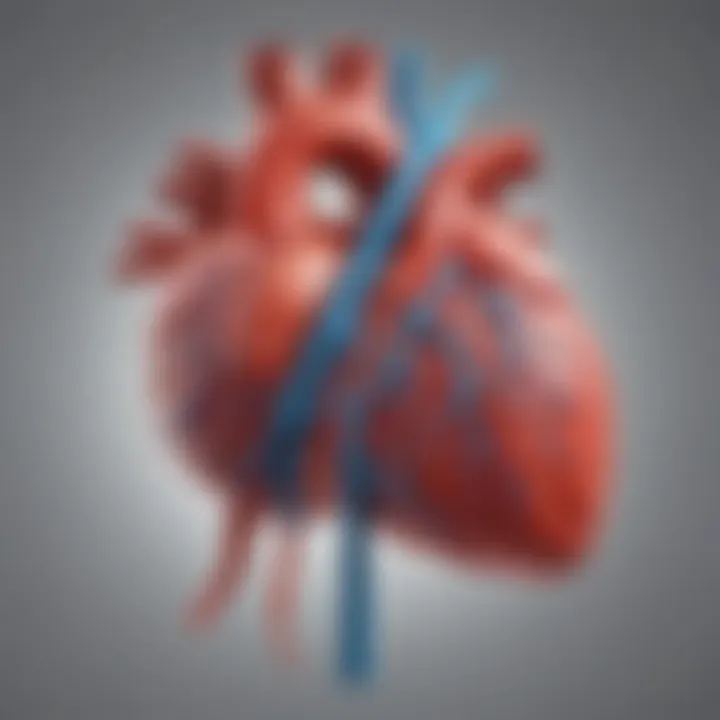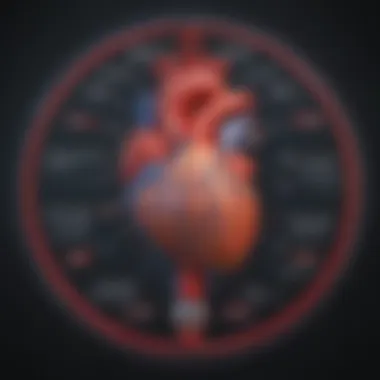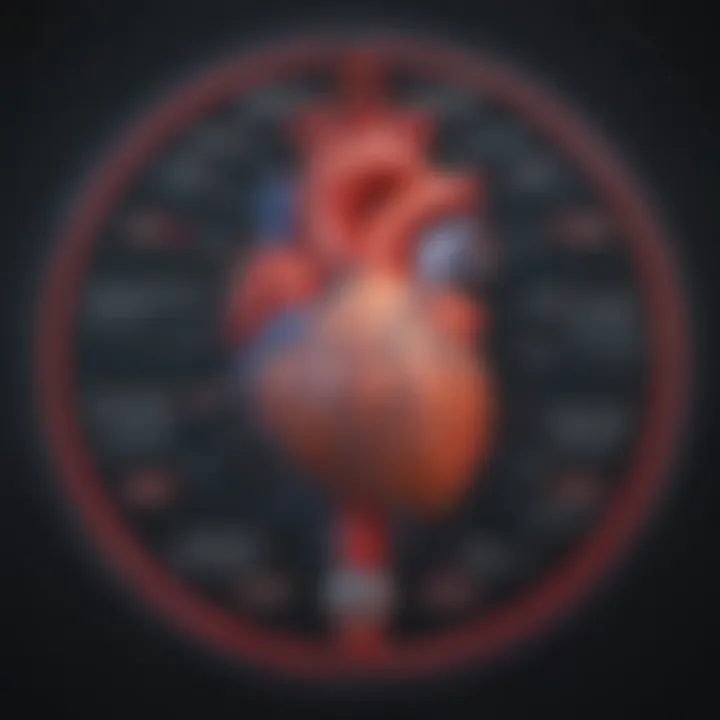Understanding the Links Between Heart Disease and Kidneys


Intro
Understanding the interplay between various health conditions is crucial for effective patient care. Hypertensive heart disease, chronic kidney disease, and heart failure, though separate ailments, are interlinked in ways that complicate their individual management. Research shows how each of these conditions can exacerbate the others, creating a tangled web of health issues. For students, researchers, and healthcare professionals, grasping these connections is essential to improve treatment approaches and patient outcomes.
The nature of this article is to dissect how hypertension serves as a catalyst for heart disease, which in turn adversely affects kidney function. This cyclic relationship leads to a significant decline in health for those affected. By delving into the underlying mechanisms, risk factors, and contemporary treatment options, we aim to shed light on how an integrated management approach can help tackle these chronic conditions more effectively.
Key Findings
Summary of the main results
Research indicates a strong correlation between these three diseases. It is clear that hypertension can lead to both heart disease and kidney disease — a "two-for-one" deal that few patients bargain for.
- Hypertensive Heart Disease: Chronic high blood pressure can thickens the heart muscle. This makes it less effective at pumping, leading to heart failure.
- Chronic Kidney Disease: The kidneys suffer as blood pressure remains persistently elevated, damaging their filters and further straining heart health.
- Heart Failure: When the heart cannot pump effectively, fluid builds up, again impacting kidney function, leading to a downward spiral of health.
Additionally, factors such as lifestyle choices, genetics, and even medication adherence play a significant role in this complex relationship.
Significance of findings within the scientific community
The implications of these findings resound within the healthcare community, provoking discussions on how to better coordinate care among specialists. This is a poignant reminder that healthcare professionals must approach these conditions holistically, considering how hypertension influences both cardiac and renal systems. Advocating for integrated care solutions can potentially mitigate the impacts of these diseases on extensive patient populations.
Implications of the Research
Applications of findings in real-world scenarios
The findings shed light on the urgent need for combined treatment strategies. Multiple studies suggest that addressing hypertension early can control or even halt the discouraging progression towards heart and kidney diseases.
- Standardized Protocols: Healthcare providers should create streamlined protocols for monitoring blood pressure, heart function, and kidney health in patients presenting symptoms across these conditions.
- Patient Education: Educating patients on managing hypertension can empower them to take control of their health, potentially preventing the onset of more severe conditions.
Potential impact on future research directions
As researchers continue to explore these interconnections, future studies may investigate more targeted treatments, personalized medicine approaches, and social determinants that contribute to these diseases. This could include factors like socio-economic status, dietary habits, and access to healthcare services. The goal: create a comprehensive understanding that could revolutionize the management of hypertensive heart disease, chronic kidney disease, and heart failure.
"A symptom may be acute, but the roots often lay deep, entwined in habits, health choices, and our very biology. Addressing these overlapping conditions requires not just awareness, but action."
Unraveling this information encourages both healthcare providers and patients to take a more proactive stance on their health, reminding us that a holistic perspective is not merely beneficial but rather necessary. The future of patient care lies in understanding these interconnected conditions and addressing them collectively.
Understanding Hypertensive Heart Disease
Hypertensive heart disease occupies a pivotal role in the broader landscape of cardiovascular health. It refers to the various impairments that arise due to prolonged high blood pressure—that little number that often goes unnoticed until it wreaks havoc. In this section, we will dissect its significance, emphasizing why understanding hypertensive heart disease is crucial for both clinicians and patients.
The relevance of hypertensive heart disease extends far beyond the heart itself. Here are some key insights:
- Integration of Systems: The heart isn’t a lone player. It is deeply tied to various systems, including the kidneys and vascular networks. Consequently, issues in these areas can exacerbate or even cause hypertensive conditions.
- Risk Identification: Recognizing the signs and symptoms of hypertensive heart disease can aid in earlier diagnosis and treatment, potentially shifting the tides in a patient’s prognosis.
- Pathophysiological Links: Comprehending the chronic effects of hypertension provides a roadmap for understanding its relationship with heart failure and kidney disease.
The primary elements we'll focus on in this article regarding hypertensive heart disease include definitions, pathophysiology, and clinical manifestations, including two specific facets: left ventricular hypertrophy and associated heart rhythm abnormalities. These components together compose a chain of implications that reveal much about how hypertension can lead to complications.
Understanding such connections is important, as it guides healthcare providers in tailoring effective management and intervention strategies.
Definitions and Key Concepts
Before we dive deeper into the nuances, let’s clarify what we mean by hypertensive heart disease. Essentially, it encompasses the damage to the heart caused by chronic high blood pressure. More formally, it includes conditions such as left ventricular hypertrophy, coronary artery disease, and heart failure. These diseases emerge not in isolation, but as consequences of the body’s relentless struggle against elevated forces at play—a fight that often goes on for years, unseen.
The key concepts to grasp here include:
- Hypertension: Defined by consistently high blood pressure readings.
- Heart Disease: Refers to various types of heart conditions, including but not limited to coronary artery disease, heart failure, and arrhythmias.
Looking closer, a fundamental point of intersection emerges: the body’s responses to high blood pressure, often leading to cardiovascular stress.
Pathophysiology of Hypertension
To appreciate the gravity of hypertensive heart disease, one must delve into the underlying mechanics, or pathophysiology, driving hypertension. Starting from the moment blood pressure rises, numerous changes kick in. For instance, the walls of the heart thicken—a consequence of the heart working harder than it has any right to. This thickening, although part of the body’s adaptation process, is fundamentally disturbing as it alters how the heart operates.
Chronic high blood pressure triggers a cascade of reactions, such as:
- Increased Cardiac Output: Initially, the heart compensates by pumping more blood. Over time, this leads to structural changes and dysfunction.
- Vascular Remodeling: The blood vessels also undergo changes, narrowing and becoming less pliable, which exacerbates the cycle of hypertension.
Thus, understanding the pathophysiology provides a solid foundation for effectively addressing and treating hypertensive heart disease.
Clinical Manifestations
As hypertension progresses, its repercussions manifest in various ways. Two notable areas warrant particular attention—left ventricular hypertrophy and heart rhythm abnormalities.
Symptoms of Left Ventricular Hypertrophy
This condition, a hallmark of prolonged hypertension, arises when the left ventricle works overtime to compensate for increased pressure in the heart. It’s crucial because it serves as a precursor to greater complications like arrhythmias or even heart failure. The key characteristic of this hypertrophy is the thickened ventricular walls, which diminish the chamber's ability to fill with blood efficiently. This can eventually lead to a decrease in the heart's output, leaving it struggling to meet the body's demands.
From a clinical perspective, left ventricular hypertrophy is significant to highlight in this article, as its early identification can lead to timely intervention. Patients may experience symptoms such as:
- Shortness of breath during exertion
- Fatigue
- Chest pain
Such manifestations, while not unique, are indicators of deeper issues that can compound if left unchecked.
Heart Rhythm Abnormalities
Another concerning complication of hypertensive heart disease is the development of heart rhythm abnormalities. These irregularities can manifest as palpitations or even lead to more serious events like atrial fibrillation. The increased pressure and structural changes in the heart affect the electrical conduction system, which governs the heart’s rhythm.
What makes this noteworthy in our discussion is that these abnormalities not only contribute to the deterioration of heart function but also increase the risk of stroke. The nature of these irregularities can lead to varying degrees of symptoms, from mild discomfort to severe cardiovascular events. Learning to recognize these symptoms and understanding their implications can be tantamount to saving lives.


"Hypertension is often called the silent killer—its effects, though insidious, have the potential to reshape one’s cardiovascular health dramatically."
In summary, grasping hypertensive heart disease is essential for recognizing its far-reaching effects on heart and kidney health. Each symptom, whether it’s left ventricular hypertrophy or heart rhythm disturbances, embodies a facet of a larger narrative, one that underscores the need for comprehensive management strategies.
Chronic Kidney Disease Overview
Understanding chronic kidney disease (CKD) is pivotal in the broader context of hypertensive heart disease and heart failure. CKD represents a gradual loss of kidney function, which plays a crucial role in maintaining the body’s internal environment by filtering waste products, balancing electrolytes, and regulating fluids. This section will illuminate the significance of CKD, emphasizing its keeping intertwined with the heart and hypertension.
Definition and Staging
Chronic kidney disease is classified into five stages based on the glomerular filtration rate (GFR), a measure of kidney function. As the disease deteriorates, the ability of kidneys to filter waste declines, leading to a cascade of complications. Early detection is critical. The stages range from mildly decreased function in stage 1 to kidney failure in stage 5, often requiring dialysis or kidney transplantation.
- Stage 1: GFR of 90 or above, with other evidence of kidney damage.
- Stage 2: GFR between 60 to 89, mild reduction in function.
- Stage 3: GFR of 30 to 59, signifies moderate damage.
- Stage 4: GFR of 15 to 29, severe functional decline.
- Stage 5: GFR below 15, end-stage renal disease.
Identifying CKD in its earlier stages allows for interventions that can significantly improve patient health outcomes and quality of life.
Causes of Chronic Kidney Disease
The etiology of CKD is multifactorial, with diabetes mellitus and hypertension being two of the most prevalent contributing factors.
Diabetes Mellitus
Diabetes is a leading cause of CKD. It leads to kidney damage through chronically elevated glucose levels that cause changes in kidney structure. Over time, high blood sugar can stiffen blood vessels and impair their ability to filter fluids efficiently. An important aspect to note is that renal complications from diabetes can arise even before diabetes is diagnosed, making screening and monitoring essential.
- Key Characteristic: Chronic hyperglycemia drives a process called nephropathy, which gradually destroys kidney tissues, leading to scarring.
- Unique Feature: Diabetic nephropathy develops in stages and is often asymptomatic in early phases.
- Advantages/Disadvantages: While managing diabetes effectively can slow CKD progression, poor management can accelerate kidney degradation significantly.
Hypertension
Hypertension plays a dual role in kidney health; it can be both a cause and a consequence of CKD. Elevated blood pressure can cause damage to the renal blood vessels, thus compounding kidney disease. Conversely, CKD can lead to increased blood pressure due to fluid retention and other hormonal changes.
- Key Characteristic: High blood pressure increases the pressure in the kidney’s filtering units, causing them to overwork, which eventually leads to damage.
- Unique Feature: Unlike diabetes, hypertension can sometimes develop without any noticeable symptoms until significant damage has occurred, underscoring the need for regular blood pressure checks.
- Advantages/Disadvantages: Tight control of blood pressure, using medications or lifestyle changes, can significantly slow CKD progression, but poorly controlled hypertension exacerbates kidney decline rapidly.
Clinical Features and Complications
Understanding the clinical features and potential complications of CKD is vital in recognizing how it exacerbates systemic health issues, including heart disease.
Electrolyte Imbalances
Renal function is crucial for maintaining electrolyte balance, and CKD can cause significant shifts in potassium, sodium, and phosphate levels.
- Key Characteristic: Imbalances often manifest as hyperkalemia, which can lead to cardiac arrhythmias, as well as skeletal muscle weakness.
- Unique Feature: Certain imbalances (like hypocalcemia) may further complicate situations with CKD and can lead to secondary hyperparathyroidism.
- Advantages/Disadvantages: Correct management requires routine monitoring, which can prevent severe complications and improve overall outcomes.
Anemia and Bone Disease
Anemia is another common complication of CKD due to decreased production of erythropoietin, a hormone responsible for red blood cell production.
- Key Characteristic: Anemia in CKD can lead to fatigue and decreased quality of life, further compounding the fatigue often seen in heart failure patients.
- Unique Feature: Bone disease often arises due to imbalances in minerals and hormones that affect bone health, making patients prone to fractures.
- Advantages/Disadvantages: Effective management focuses on treating the underlying cause, which can significantly improve a patient’s life quality while concurrently reducing heart failure risks.
In summary, chronic kidney disease is much more than a standalone condition; it intertwines with hypertension and contributes significantly to heart failure. By understanding its definitions, causes, and complications, healthcare professionals are better equipped to formulate effective management strategies that enhance patient outcomes.
The Intersection of Hypertension and Kidney Function
Understanding the relationship between hypertension and kidney function is crucial in the discussions surrounding hypertensive heart disease and chronic kidney disease. A well-functioning kidney is vital not only for filtering blood but also for maintaining fluid and electrolyte balance and regulating blood pressure itself. Therefore, when hypertension complicates kidney function, it sets off a cascade of health issues that can have far-reaching effects on multiple systems in the body. From renal impairment to the exacerbation of heart failure, the interconnections create a complex web of pathophysiological responses that highlight the need for an integrated therapeutic approach toward management.
How Hypertension Affects Kidney Health
Hypertension can exert significant damage on kidney tissues over time, driving a wedge between the few remaining functional nephrons. Elevated blood pressure leads to increased glomerular filtration rate initially; however, this is often a double-edged sword. Over time, the chronic overload leads to glomerulosclerosis—essentially scarring of the kidney tissue. This not only diminishes the kidney's ability to filter waste but also impacts its endocrine functions. Key processes like the regulation of sodium and potassium will be altered, resulting in further elevation of blood pressure.
Implications for patients:
- Impaired kidney function often generates a vicious cycle whereby the retention of toxins further exacerbates hypertension.
- Patients are at greater risk for developing proteinuria, which can significantly complicate their clinical picture.
- Electrolyte imbalances become common, leading to additional difficulties in managing overall health.
Renal Artery Narrowing
One of the more severe consequences of sustained hypertension is renal artery narrowing, medically known as renal artery stenosis. Caused by atherosclerosis or fibromuscular dysplasia, this condition results in reduced blood flow to the kidneys. As the kidney perceives low blood flow, it activates compensatory mechanisms, including the renin-angiotensin-aldosterone system. This ends up raising systemic blood pressure further, creating an unhealthy feedback loop.
"The kidneys are usually the sentinels that regulate fluid balance; however, with renal artery narrowing, they can inadvertently become the harbingers of hypertension."
Key points of concern:
- Renal artery stenosis can lead to abdominal or flank pain, and often manifests with an audible bruit upon physical examination.
- The condition may contribute to worsening hypertension, making it extremely challenging to manage blood pressure effectively.
- If untreated, the long-term consequences of renal artery narrowing can include eventual kidney failure, making surgical interventions necessary in some cases.
In summary, the intersection of hypertension and kidney function serves as a critical juncture in the understanding of hypertensive heart disease and chronic kidney disease. Acknowledging how hypertension impacts kidney health, particularly through mechanisms like renal artery narrowing, is essential for developing effective management strategies.
Heart Failure and its Types
Heart failure serves as a significant outcome in the continuum of hypertensive heart disease and chronic kidney disease. It highlights the desperate need to comprehend mechanisms that tie these conditions together, as it often manifests from the cumulative damage brought on by hypertension and renal impairment. Understanding heart failure is not just about recognizing the symptoms; it’s about grasping how the heart’s efficiency decreases, leading to a cascading effect that impacts both patient quality of life and appropriate management strategies. By delving into specific types of heart failure, practitioners can best tailor interventions, thereby improving patient outcomes.
Definition and Mechanisms
Heart failure is a complex syndrome marked by the heart's inability to pump blood adequately to meet the body's needs. This deficiency may result from structural heart disease, dysfunction related to hypertension, or changes in the kidney that prompt improper fluid balance. The left ventricle often bears the brunt of the workload, which reinforces the link between heart and kidney health.
"Heart failure is essentially the body’s signaling system that something is fundamentally wrong with the cardiovascular status of an individual."
Several mechanisms contribute to heart failure, including increased vascular resistance, inflammatory processes, and volume overload. With hypertensive heart disease on one hand and chronic kidney disease on the other, clinicians must pay close attention to the dynamic interplay that exists between these systems.
Types of Heart Failure


The classification of heart failure simplifies the recognition of specific patient needs and the tailoring of treatments. Understanding each type can lead to different management strategies and patient prognoses. The three main categories are left-sided heart failure, right-sided heart failure, and congestive heart failure, each showcasing unique clinical features and implications.
Left-Sided Heart Failure
Left-sided heart failure primarily occurs when the left ventricle cannot effectively pump blood to the body, causing fluid backup into the lungs. This type often emerges from prolonged hypertension or heart valve disease. A characteristic symptom is the presence of pulmonary congestion, leading patients to experience shortness of breath, especially during exertion or while lying down.
The significance of left-sided heart failure in this discussion is paramount. Its occurrence leads to direct respiratory complications and can exacerbate chronic kidney disease through elevated blood pressures and altered renal perfusion. It exemplifies how one system's malfunction influences another, establishing a perpetual cycle of decline.
Right-Sided Heart Failure
Right-sided heart failure occurs when the right ventricle struggles to pump blood to the lungs, causing a backlog of blood in the systemic circulation. This condition may arise from left-sided heart failure or chronic obstructive pulmonary disease, contributing to symptoms such as leg swelling and abdominal discomfort.
A vital feature of this type is fluid accumulation beyond the lungs, pointing towards the interconnected nature of heart function and kidney health. As blood returns to the heart but encounters obstacles, the kidneys suffer from inadequate perfusion, potentially aggravating kidney impairment further.
Congestive Heart Failure
Congestive heart failure encompasses both left and right-sided failures, signifying that the heart is unable to maintain adequate circulation regardless of the side. Individuals with this condition may quickly experience significant limitations in both physical activity and normal daily functioning. A striking characteristic of congestive heart failure is edema—swelling due to fluid gather—in various body parts as generalized congestion ensues.
The comprehensive nature of congestive heart failure illustrates the culmination of heart disease and renal insufficiency. Managing this condition requires not only treating heart dysfunction but also addressing the underlying factors affecting kidney health, ensuring a holistic approach to patient care.
The types of heart failure are more than academic distinctions; they inform treatment pathways and patient prognoses. Understanding these categories fosters better management, emphasizing the necessity for coordinated care among specialists to mitigate the adverse effects of each condition on the others.
Pathophysiological Links Between the Conditions
Understanding the pathophysiological links between hypertensive heart disease, chronic kidney disease, and heart failure is crucial in grasping how these conditions interweave to affect patient health. Each condition, while impactful on its own, often acts as a catalyst for the others in a vicious cycle that can be difficult to break. This interplay highlights the importance of a holistic view when assessing and treating individuals with these ailments.
The Role of Inflammation
Inflammation serves as a common thread tying together the dysfunction seen in hypertensive heart disease and chronic kidney disease. When blood pressure rises, the body reacts with inflammatory processes that can lead to various cardiovascular and renal issues. Practically, elevated hypertension triggers the release of pro-inflammatory cytokines. These are proteins that can cause damage to heart and kidney tissues, accelerating the onset of disease.
In chronic kidney disease, inflammation worsens as the kidneys fail to filter out waste. This leads to a toxic environment which exacerbates cardiac dysfunction. Studies show that inflammatory markers, such as C-reactive protein, are significantly elevated in patients suffering from both hypertension and kidney disease. This observation suggests that targeting inflammation not only holds promise for improving heart health but could also protect kidney function.
Cytokines play a dual role: they are essential in our immune response but also contribute to the deterioration of heart and kidney health in chronic diseases.
Fluid Overload and Its Consequences
Fluid overload is another significant concern in the triad of hypertensive heart disease, chronic kidney disease, and heart failure. As blood pressure remains high, the heart's ability to pump effectively diminishes, ultimately leading to fluid retention. The kidneys, already compromised by chronic conditions, cannot adequately excrete this excess fluid.
Eventually, this overload results in swelling, hypertension, and can even lead to a dangerous scenario known as congestive heart failure. Patients may experience symptoms like shortness of breath and extreme fatigue. Recognizing this link is vital, as it can guide treatment choices, such as diuretics that alleviate fluid retention while also addressing blood pressure.
Risk Factors and Vulnerable Populations
Understanding the risk factors associated with hypertensive heart disease, chronic kidney disease, and heart failure is critical for managing these interconnected conditions. Recognizing the populations that are most vulnerable allows healthcare providers to implement preventive strategies that can significantly alter disease trajectories. This section brings to light both demographic and lifestyle factors that play a key role in the onset and progression of these diseases.
Demographic and Genetic Influences
Demographic factors, including age, gender, and ethnicity, significantly contribute to the prevalence of hypertensive heart disease and its relatives. For example, older adults often face escalating hypertension levels due to age-related arterial stiffness and other physiological changes. Interestingly, certain populations, such as African Americans, experience higher incidents of hypertension and its complications, likely influenced by both genetic predisposition and social determinants of health.
Moreover, genetics can reveal a wealth of information when assessing risk. The presence of hypertension-related genetic markers can sometimes hint towards a person's likelihood of developing chronic kidney disease or heart failure, well before any symptoms appear. With advancements in genetic testing, it is becoming increasingly feasible for individuals to understand their predisposition to these conditions, allowing for earlier interventions and tailored management strategies. Education about these risks is crucial, empowering individuals to make informed lifestyle choices that can mitigate their risk.
Lifestyle Factors
Lifestyle plays an undeniable role in the landscape of hypertensive heart disease, chronic kidney disease, and heart failure. Stressors brought on by poor dietary habits, lack of physical activity, and behavioral patterns can be detrimental to heart and kidney health.
Obesity
Obesity is one of the prominent risk factors associated with hypertension. It intricately ties into insulin resistance, where the body becomes less responsive to insulin—a condition often leading to metabolic syndrome, which further exacerbates heart failure and kidney disease. The key characteristic of obesity is its multifactorial nature: influenced by genetics, environment, and behavior, and it tends to be a strong predictor of cardiovascular stress.
One unique feature of obesity is its potential to create a vicious cycle of health issues. Excess weight increases sodium retention, which leads to increased blood pressure. In turn, hypertension strains the heart and kidneys, escalating the risk of heart failure and chronic kidney issues. Addressing obesity, therefore, surfaces as a fundamental strategy in preventing the cascading effects leading to debilitating health conditions.
Sedentary Behavior
Sedentary behavior is another critical factor that warrants attention. Sitting for prolonged periods without much physical activity is a common part of modern life, contributing to a range of health complications, including increased body weight and cardiovascular strain. One key aspect of this behavior is the underestimation of its significance. People often overlook it, thinking that just being active for a part of the day can counterbalance long hours of inactivity.
However, it is not quite that simple. Sedentary lifestyles lead to poor circulation and increase hypertension risks, while also influencing kidney function. The unique feature of such behavior lies in its insidious nature; it does not always present immediate effects, which could lure individuals into a false sense of security. The longer sedentary habits persist, the more detrimental their impact becomes on heart and kidney health. Recognizing these lifestyle factors as critical risk contributors will enable a more targeted approach for prevention and management.
"Awareness of risk factors is the first step toward effective prevention and treatment. It’s essential for both individuals and healthcare practitioners to stay informed."
By addressing these risk factors related to demographic influences and lifestyle choices, we can begin to unravel the broader narrative of how hypertensive heart disease, chronic kidney disease, and heart failure interrelate. Effective management hinges on understanding these underlying vulnerabilities, opening avenues for early intervention and comprehensive care.
Diagnosis and Risk Stratification
Understanding the processes behind diagnosis and risk stratification is crucial, especially when dealing with interrelated conditions such as hypertensive heart disease, chronic kidney disease, and heart failure. These three maladies often coexist, complicating treatment strategies and patient outcomes. Recognizing how to effectively assess and stratify risk can offer more tailored and potentially effective management plans. By identifying not just the presence, but the extent and severity of these conditions, healthcare providers can craft a more integrated approach to treatment, ensuring that no aspect of a patient’s health is neglected.
Diagnostic Tests for Heart Disease
Echocardiogram
Echocardiograms play a pivotal role in diagnosing heart conditions, particularly hypertensive heart disease. This ultrasound imaging test offers real-time pictures of the heart’s movement and structure, which allows clinicians to assess the size, shape, and function of the heart's chambers and valves. One of its standout features is the ability to visualize any hypertrophy or the thickening of the heart muscle, a common result of chronic high blood pressure.
The beauty of an echocardiogram lies in its non-invasiveness; patients often appreciate that there are no needles or invasive instruments involved. It allows healthcare professionals to pinpoint issues like decreased heart function or persistent left ventricular hypertrophy, impacting treatment choices also related to kidney function. However, understanding its limitations is crucial. For example, the quality of the images can sometimes be affected by a patient’s body habitus, which might mask underlying issues.
Electrocardiogram
The electrocardiogram, or ECG, is another fundamental tool in cardiovascular diagnosis. By tracking electrical impulses in the heart, it maps the rhythm and identifies any abnormalities in heart function. An ECG is simplistic in its application, as it is quick to perform and results are often immediate, making it widely regarded in emergency settings.
One of its key characteristics is the ability to detect arrhythmias and signs of left ventricular hypertrophy as well, which links it neatly with our discussion of hypertensive heart disease. Its simplicity can be both an advantage and a drawback; while it can flag many heart issues efficiently, it may not provide a detailed view of structural anomalies, where an echocardiogram may have the upper hand. Thus, both tests often complement each other when diagnosing heart disease.


Assessing Kidney Function
Serum Creatinine
When dealing with chronic kidney disease, serum creatinine is a fundamental marker to evaluate kidney function. It measures the level of creatinine, a waste product formed from muscle metabolism, which the kidneys should filter out. If kidneys are not functioning well, the creatinine levels can rise, offering crucial insight into renal health.
The significance of measuring serum creatinine lies in its direct correlation to the Glomerular Filtration Rate (GFR), an important indicator of overall kidney performance. A benefit of this test is its relative ease and low cost. However, there’s a caveat; creatinine levels can be influenced by various factors such as muscle mass and hydration status, potentially skewing results.
Urinalysis
Urinalysis offers another window into kidney function and overall metabolic health. This examination not only checks for the presence of substances like protein or blood but can also indicate hydration levels, infections, and metabolic conditions. Its non-invasive nature makes it a patient-friendly approach.
What stands out in urinalysis is its ability to yield a comprehensive narrative about kidney status at a glance. While not as direct as serum creatinine in evaluating kidney function quantitatively, it can reveal qualitative changes. An elevated protein level, for example, can signal early kidney damage and intertwined issues such as heart disease. Yet, while effective, urinalysis should often be paired with quantitative tests like serum creatinine for a thorough appraisal.
In summary, both diagnostic tests and assessments of kidney function serve as the cornerstone for understanding and managing hypertensive heart disease, chronic kidney disease, and heart failure. Together, they can significantly improve patient outcomes through precision and context in their evaluation.
Management Strategies
Effective management strategies for hypertensive heart disease, chronic kidney disease, and heart failure represent a cornerstone of contemporary healthcare. The interrelation among these conditions often demands an integrated approach, highlighting the importance of tailored interventions. Addressing this trio requires a keen understanding of pharmacological and lifestyle management options that can mitigate risks and improve patient outcomes.
When treating patients affected by these interlinked diseases, healthcare providers must not only focus on alleviating symptoms but also on preventing further deterioration. The key is to create a personalized care plan that accommodates the individual patient's needs while taking into account the distinct characteristics of each condition. This could mean using a combination of medications that target hypertension and kidney function, alongside essential lifestyle modifications that enhance overall health.
Pharmacological Interventions
Antihypertensive Medications
Antihypertensive medications play a vital role in managing high blood pressure, an underlying factor exacerbating hypertensive heart disease and kidney dysfunction. These drugs help lower blood pressure and reduce complications associated with chronic conditions. One of the key characteristics of antihypertensive agents is their diversity. There are various classes, including diuretics, beta-blockers, and calcium channel blockers, which allow healthcare providers to tailor treatment based on patient-specific factors.
The choice of antihypertensive medication hinges on its ability to not only manage hypertension but also its overall safety profile and effectiveness in kidney protection. Commonly prescribed medications, such as lisinopril or amlodipine, can effectively lower blood pressure while providing additional renal benefits. For instance, the unique feature of diuretics is their potential to relieve fluid overload, particularly in patients with heart failure, though they may lead to electrolyte imbalances. This trade-off is a significant consideration that must be addressed throughout the treatment journey.
Renin-Angiotensin-Aldosterone System Inhibitors
Renin-angiotensin-aldosterone system (RAAS) inhibitors target pathways that refine blood pressure control, and they have found favor in clinical practice for patients with both hypertensive heart disease and chronic kidney disease. These agents, including losartan and enalapril, function by relaxing blood vessels, thus decreasing blood pressure while simultaneously enhancing renal blood flow.
One of the standout features of RAAS inhibitors is their dual action concerning cardiovascular and kidney protection. They not only manage hypertension but also counter renal damage by reducing proteinuria – an important marker of kidney health. However, while these medications offer significant benefits, monitoring is essential since they can sometimes lead to increases in serum potassium or alterations in renal function.
Lifestyle Modifications
While pharmacological interventions are crucial, lifestyle modifications cannot be overlooked. Adopting healthier habits plays a significant role in managing blood pressure, enhancing kidney health, and consequently reducing the risk of heart failure.
"Lifestyle changes are not just complementary interventions; they are critical to the overall success of managing chronic diseases."
Key modifications include:
- Dietary Improvements: Following a balanced diet rich in fruits, vegetables, whole grains, and low in sodium can significantly reduce blood pressure. The DASH diet is particularly effective in this regard.
- Regular Exercise: Engaging in regular physical activity aids in weight management and enhances cardiovascular health, directly influencing blood pressure levels.
- Smoking Cessation: Eliminating tobacco smoke can improve both heart and kidney function over time.
- Alcohol Moderation: Limiting alcohol intake further helps maintain a healthy blood pressure.
Adopting these lifestyle measures not only provides immediate benefits but also fosters long-term health, reinforcing the body’s ability to respond to any pharmacological treatments.
Future Directions in Research
The convergence of hypertensive heart disease, chronic kidney disease, and heart failure has sparked significant interest in the medical community. As research continues to evolve, understanding the future directions in this field will be crucial for enhancing patient care and outcomes. This section delves into emerging pharmacological advances and the potential role of technology in monitoring these intertwined conditions.
Emerging Pharmacological Advances
Recent years have seen a flurry of activity in developing drugs aimed at treating hypertension and its sequelae. Innovative therapies are being designed not only to lower blood pressure but also to protect renal function and improve cardiac health. For instance, novel agents like sacubitril/valsartan are proving beneficial in managing heart failure, demonstrating a dual-action effect that mitigates blood pressure while promoting heart efficiency.
Additionally, drugs targeting the Renin-Angiotensin-Aldosterone System (RAAS) like angiotensin receptor-neprilysin inhibitors (ARNIs) can offer hope by preventing kidney damage long before it becomes irreversible. These advancements underscore the shift towards a more holistic approach to treatment—one that considers the heart and kidneys as interconnected organs rather than isolated systems.
Important benefits of these emerging treatments include:
- Reduced hospitalization rates due to complications of heart failure.
- Preservation of renal function in patients with chronic kidney disease.
- Improved quality of life for patients through better symptom management.
However, considerations must be made regarding potential side effects, patient compliance, and accessibility of these newer therapies. Continuous clinical trials will be paramount in validating their long-term efficacy and safety for broader applications.
Potential Role of Technology in Monitoring
Emerging technologies present an exciting frontier in monitoring hypertensive heart disease and chronic kidney disease. Innovations such as wearable devices and telehealth platforms allow for real-time data collection, enabling better management of these conditions. Imagine a scenario where a patient’s heart rate, blood pressure, and kidney function metrics are monitored constantly—alerts can be sent to healthcare providers at any sign of abnormality.
Wearable tech can assist in:
- Tracking vital signs continuously to detect early changes
- Enabling remote consultations, thereby minimizing hospital visits
- Involving patients more actively in their own care decisions
Additionally, artificial intelligence and machine learning can analyze vast amounts of data from these devices, promoting personalized treatment plans based on individual patient patterns. For instance, algorithms could assess a patient's adherence to medication, prompting healthcare providers with actionable insights to enhance therapy adherence.
"The intersection of technology with healthcare has the potential to improve outcomes by streamlining patient monitoring and enhancing proactive care strategies."
As technology advances, it becomes crucial to address privacy concerns and ensure that collected data is secure and used responsibly. Ongoing research into technology interventions could lead to better health outcomes and reduce the burden on healthcare systems.
In summary, the future of research into hypertensive heart disease, chronic kidney disease, and heart failure looks promising, with both pharmacological and technological advances offering significant potential. By focusing on these innovative areas, healthcare professionals can better target interventions, improve patient quality of life, and ultimately pave the way toward a healthier future.
The End
The intersection of hypertensive heart disease, chronic kidney disease, and heart failure highlights a profound interplay of medical conditions that are often underestimated in their collective impact on health. Understanding how these conditions intertwine is crucial not only for healthcare providers but also for patients navigating their health journeys.
In recognizing this interconnection, healthcare professionals can take a more holistic approach to treatment. For instance, managing hypertension effectively is imperative to prevent further damage to the heart and kidneys. Patients with elevated blood pressure must be monitored closely as they are at a higher risk for developing both heart disease and kidney dysfunction.
Key elements to consider in the management of these conditions include:
- Comprehensive Risk Assessment: Regular screenings for kidney function in hypertensive patients can identify early signs of chronic kidney disease.
- Integrated Treatment Plans: Combining approaches to tackle hypertension, heart health, and kidney function can significantly improve patient outcomes. This means that instead of treating one issue in isolation, a multifaceted approach that addresses all related conditions is fundamental.
- Patient Education: Empowering patients with knowledge about their conditions is vital. Understanding their risk factors and management strategies allows patients to take an active role in their health.
Moreover, ongoing research into the interactions between these diseases continues to reveal new insights that may lead to more effective treatments and interventions. This brings hope to individuals affected by these chronic conditions, emphasizing that progress is underway.
"The best way to predict the future is to create it."
— Peter Drucker







